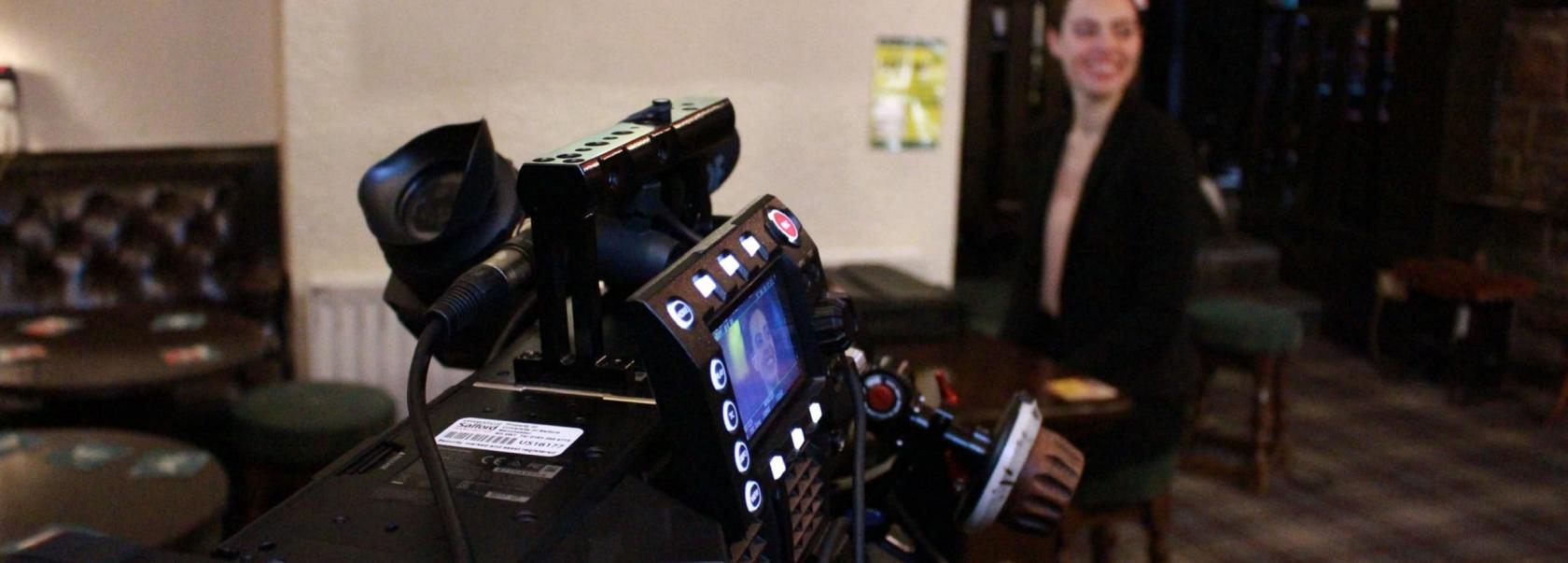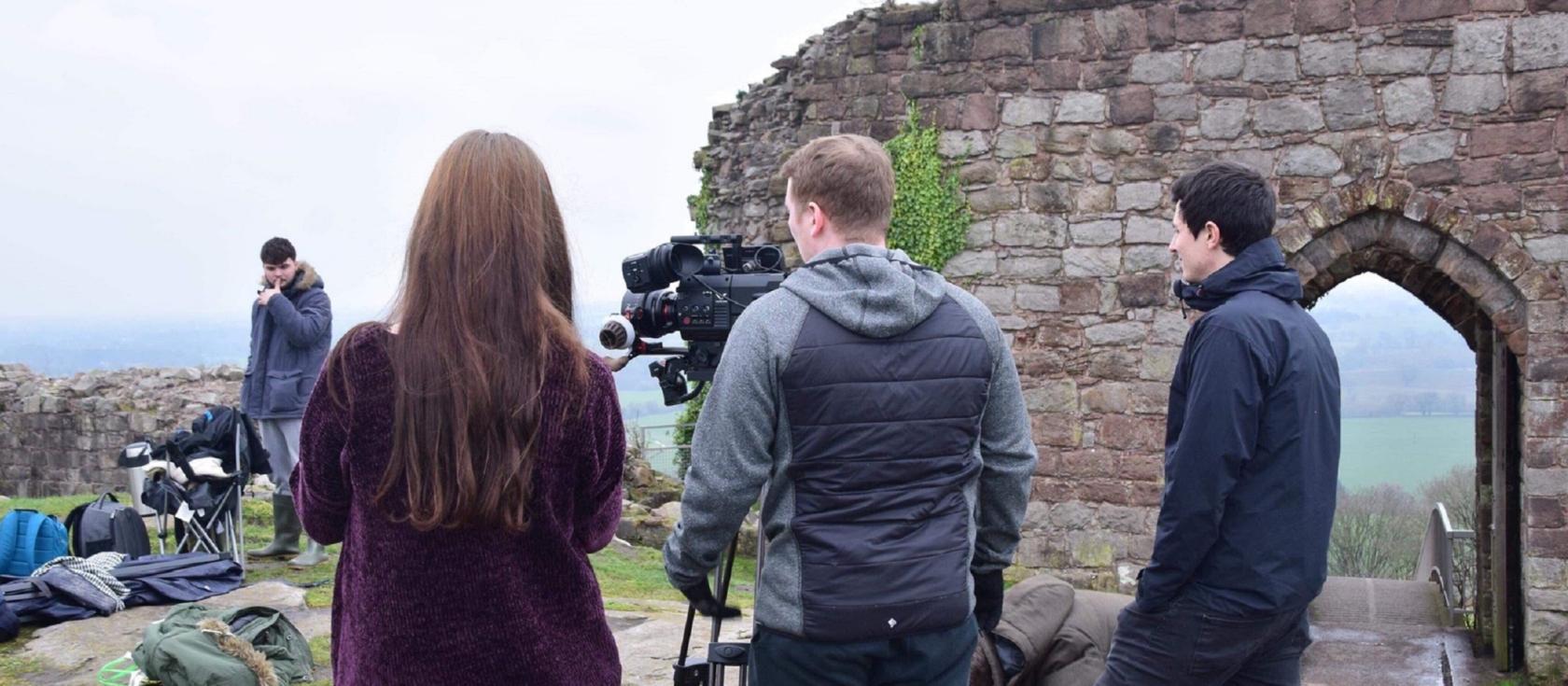Educating the next generation of film makers at The University of Salford
Breadcrumb
Educating the next generation of film makers at The University of Salford
Utilising the VariCam and EVA1 to educate film students at The University of Salford
Challenge
Providing large sensor camera technology for students to obtain a wider knowledge and understanding of filmmakingSolution
Investing in Panasonic’s 4K camera equipment, approved by Netflix’s PTA programme, ensured that the students had a high quality camera that was also easy to use"As the course is designed to lay the foundation for filmmaking, we needed a professional filming tool that would also be an educational tool"
Lecturer in Film Production at The University of Salford

The University of Salford's School of Arts and Media, partially located in the MediaCity UK campus and surrounding areas, is home to an international hub for technology, innovation, and creativity. This has made it an ideal location for the introduction of its BA (Hons) Film Production undergraduate course, set up three years ago with the aim of teaching the next generation of aspiring filmmakers.
Over a duration of three years, the Film Production degree is designed to offer students hands-on filmmaking experience supported by critical and contextual aspects of film theory, with a strong emphasis on collaborative projects throughout. Students are exposed to a wide range of high-end camera, lighting and editing equipment, to facilitate the production of short films both on location and within the studios situated in MediaCity UK.
Janan Yakula, Lecturer in Film Production at The University of Salford said, “The Film Production degree takes a holistic approach to learning, with the mixture of practice and theory intended to provide our graduates with all the skills they need to succeed in the production industry. As the course is designed to lay the foundation for filmmaking, we needed a professional filming tool that would also be an educational tool”.
This resulted in The University of Salford investing in camera technology that is being readily used within filmmaking, comprising of a total of 2x VariCam 35s, 20x VariCam LTs, 22 EVA1s and a quantity of Lumix GH5s, to be used across the course.
“We needed high quality kit that would remain up to date with the industry for our first round of graduate students, and many afterwards.”
The students are then given sole creative ownership of their short films, with the course aiming to develop filmmakers that are multi-disciplined across directing, script writing, camera operation, cinematography, editing, budgeting, marketing and distributing their films. This includes the introduction of Sound Design with Avid Pro Tools and Adobe Premiere in the first year, with editing tools including DaVinci Resolve and Avid included in the second and third.
Netflix approved
Investing into Panasonic's VariCam and EVA1 camera technology was beneficial to the University of Salford, as they wanted to provide its students with production cameras that were already being readily used for high-end feature, drama, natural history and documentary production. Yakula added, “We needed high-quality kit that would remain up-to-date with the industry for our first round of graduate students, and for many afterwards.”

Panasonic's future-proof quality was evident after the 4K cinema camera line up joined Netflix's Post Technology Alliance Partnership (PTA) programme, which assures artists and facility operators that a product meets the Netflix delivery specifications for its Original content today, and in the future.
This was beneficial for students whose exposure to Netflix Original series' such as Ozark, After Life and Orange is the New Black, all of which are credited to the VariCam, would have allowed them to see the potential for the feature-set of the cameras they would also be utilising.
A professional tool
Steven Wyatt, Academic Fellow for Film Production said, “Panasonic's line of cameras work very successfully as an educational tool from the students perspective because they can seamlessly intermix footage from the EVA1, VariCam LT and 35 footage, particularly in 10-bit 2K modes. The uniform colour science and V-Log option allows students to adopt the lineup to a wide range of shooting conditions.
The uniformity of the menu system allows students to be familiar with the multitude of cameras, subsequently increasing their overall confidence when moving between the camera systems. Commenting on the benefits of the Panasonic range for editing and grading in post-production, he added, “The option for inputting Panasonic's custom LUTs courtesy of its website allow in-class discussions on setting up looks for specific tasks.
"Filming with the VariCam for my short film made everything much easier, with every option I could possibly need available in a well organised menu system"
For example, the Hi-Con Black and White LUT has been a great tool for displaying and deconstructing lighting for Black and White in-class, as students can view the output of the camera in black and white, but still preserve the log signal for grading later.”
Another feature of the range is a dual-native ISO of 800 and 5000. Yakula added, “Features such as dual-native ISO become a crucial aspect of the students final year projects when there is not necessarily any budget available to support further lighting.” This makes the kit highly compatible with conventional film workflows, so that students can easily adapt to the digital production cameras and maintain the fundamentals of film-making.
The University of Salford concluded its first final-year undergraduate intake with an inaugural awards ceremony, where each team presented its short films. The majority of the films used a mixture of the VariCam 35 and LT, and the EVA1 together. As Sam Davies, Director of Photography for Fantopia, commented, “The VariCam and EVA1 marry up perfectly. Once the lighting is matched and the footage is graded, you can't even tell them apart. The image quality is amazing on both of the cameras.”
Davies added, “One location in particular put the low-light capability of the VariCam to the test. The shoot was in an old 1850's pub, and was mostly lit by candle light, with some panel lights boosting the ambience. We set the dual ISO to a base of 5000 and lowered it to 1250. This created an amazingly clean image for the amount of light within the scene, and the VariCam certainly worked in our favour.”
Lewis Evers, whoalso worked with Sam on Fantopia and a second-year short film, We, the Brave, commented that, “…learning the VariCam interface was a lot of fun, (and with) it being an industry camera, we as a team pushed ourselves to be more professional, and you can definitely see that in our finished films”.

Owen Siry also made use of all three cameras to film their final-year short film, The Lock Inn. Owen commented that, “…the cameras were easy to set up and use, and were easily moveable when on set. This was particularly important when we were using a multitude of locations around Manchester – from a pub interior and cellar, to an underground car park. We used the dual-native ISO to our advantage to allow us to choose the amount of light we wanted the camera to receive whilst filming”.
Following the conclusion of the awards, which included short films covering a multitude of genres, the Best Film Award was awarded to Fantopia. The majority of the teams are now looking to pitch their films to film festivals including the likes of Edinburgh and Leeds, and continue their journeys into the world of filmmaking.
Read more insights…
article
PANASONIC UNVEILS CUTTING-EDGE REMOTE CAMERA CONTROLLER WITH MACRO FUNCTIONALITY AND DUAL JOYSTICK CONTROL
Panasonic unveils groundbreaking remote camera controller that’s set to revolutionise operator workflows, featuring Panasonic’s first-ever macro functionality, dual joystick control, and seamless peripheral integration.
article
PANASONIC REDEFINES VIDEO PRODUCTION WITH NEW 4K MULTI-PURPOSE CAMERA AND WORLD’S FIRST AUTO-FOCUS FUNCTION
Panasonic unveils the AK-UBX100 4K multi-purpose camera, featuring auto-focus functionality that delivers more flexibility and precision than ever before.
Case Study
O2 Production Relies on Panasonic KAIROS for Broadcasting Top-Tier Football and Ice Hockey in Czechia
In November 2023, O2 Production secured exclusive broadcasting rights for the Czech First League and Czech Extraliga – the country’s premier football and ice hockey leagues, respectively. With only a few weeks to prepare before the end of the year, it faced the challenge of managing up to eight simultaneous live broadcasts. To meet this demand, a cutting-edge Remote Broadcast Centre was constructed in Prague’s Brumlovka district, built entirely on the SMPTE ST 2110 IP-based protocol.
article
PANASONIC APPOINTS UNIVERSITY OF STAFFORDSHIRE AS KAIROS ACADEMY PARTNER
Staffordshire is the first UK university to become a KAIROS Academy Partner, offering students a state-of-the-art eSports degree that equips them with essential industry skills.
Sorry there was an error...
The files you selected could not be downloaded as they do not exist.
You selected items.
Continue to select additional items or download selected items together as a zip file.
You selected 1 item.
Continue to select additional items or download the selected item directly.
Share page
Share this link via:
Twitter
LinkedIn
Xing
Facebook
Or copy link: